ECU OLDSMOBILE SILHOUETTE 1998 Owners Manual
[x] Cancel search | Manufacturer: OLDSMOBILE, Model Year: 1998, Model line: SILHOUETTE, Model: OLDSMOBILE SILHOUETTE 1998Pages: 444, PDF Size: 23.2 MB
Page 19 of 444
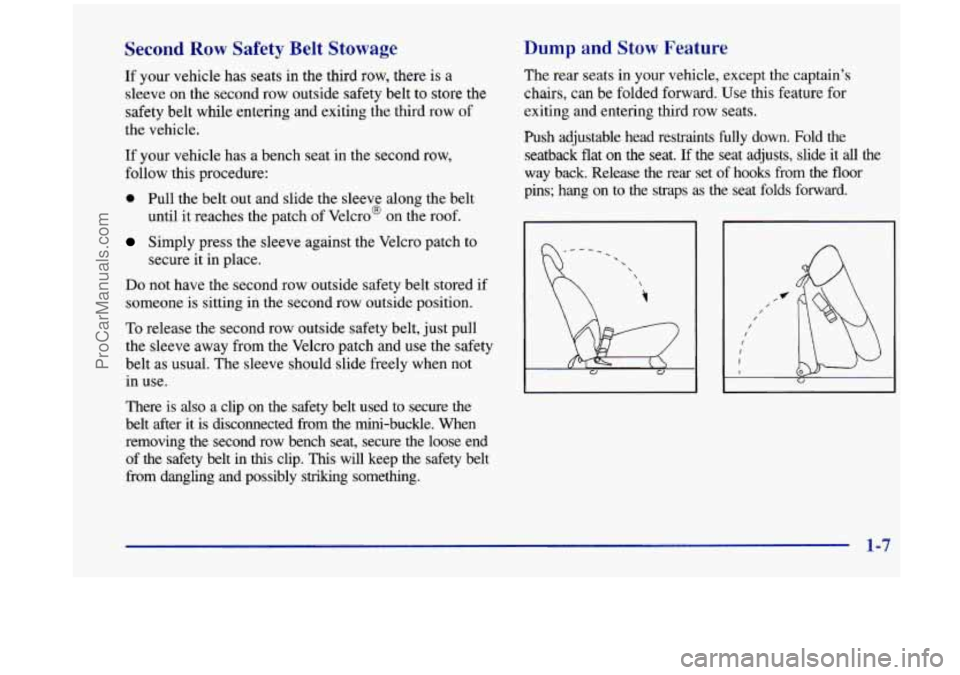
Second Row Safety Belt Stowage
If your vehicle has seats in the third row, there is a
sleeve on the second row outside safety belt to store the
safety belt while entering and exiting the third
row of
the vehicle.
If your vehicle has a bench seat in the second row,
follow this procedure:
0 Pull the belt out and slide the sleeve along the belt
until it reaches the patch of Velcro@ on the roof.
Simply press the sleeve against the Velcro patch to
bo not have the second row outside safety belt stored if
someone is sitting in the second row outside position.
To release the second row outside safety belt, just pull
the sleeve away from the Velcro patch and use the safety
belt as usual. The sleeve should slide freely when not
in use. secure it
in place.
There is
also a clip on the safety belt used to secure the
belt after it is disconnected
from the mini-buckle. When
removing the second row bench seat, secure the loose end
of the safety belt in this clip.
This will keep the safety belt
from dangling and possibly striking something.
Dump and Stow Feature
The rear seats in your vehicle, except the captain’s
chairs, can be folded forward. Use this feature for
exiting and entering third row seats.
Push adjustable head restraints fully down. Fold the seatback
flat on the seat. If the seat adjusts, slide it all the
way back. Release the rear set of hooks from the floor
pins; hang on to the straps as the seat folds forward.
I I I I I U
1-7
ProCarManuals.com
Page 42 of 444

3. Pick up the latch plate and pull the belt across you.
Don’t let it get twisted.
The shoulder belt may lock
if you pull the belt across
you very quickly. If this happens, let the belt
go back
slightly to unlock it. Then pull the belt across you
more slowly.
4. Push the latch plate into the buckle until it clicks. Pull
up on the latch plate to make sure it is secure. If
the belt isn’t long enough, see “Safety Belt
Extender’’ at the end
of this section.
Make sure the release button on the buckle is
positioned so you would be able to unbuckle the
safety belt quickly if you ever had to.
5. To make the lap part tight, pull down on the buckle
end
of the belt as you pull up on the shoulder belt.
1-30
ProCarManuals.com
Page 52 of 444
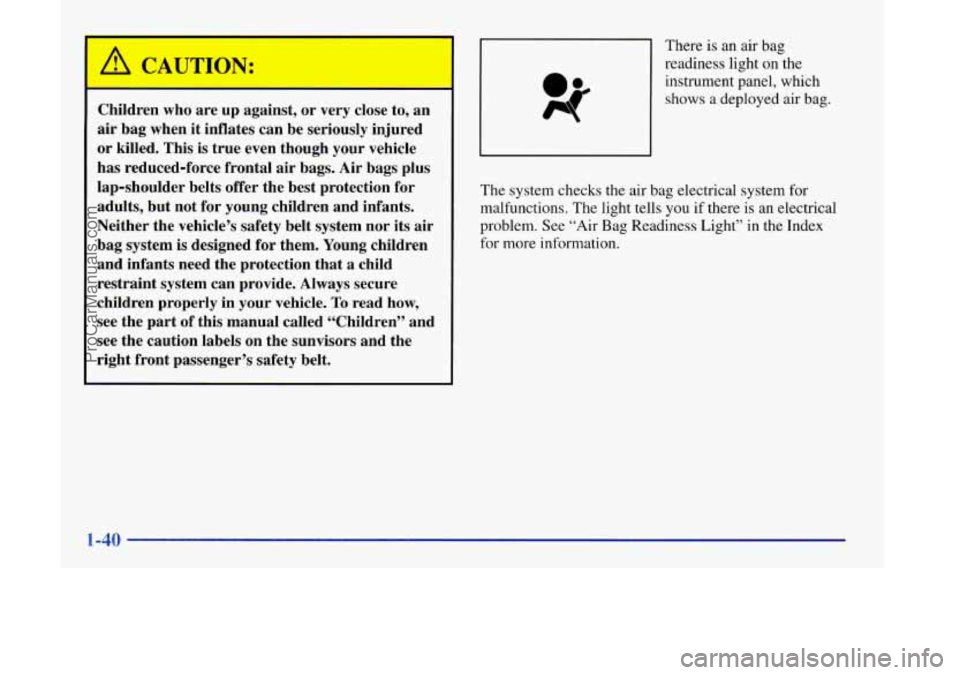
I
Children who are up against, or very close to, an
air bag when it inflates can be seriously injured
or killed. This is true even though your vehicle
has reduced-force frontal air bags. Air bags plus
lap-shoulder belts offer the best protection for adults, but not for young children and infants.
Neither the vehicle’s safety belt system nor its
air
bag system is designed for them. Young children
and infants need the protection that
a child
restraint system can provide.
Always secure
children properly in your vehicle.
To read how,
see the part of this manual called “Children” and
see the caution labels on the sunvisors and the
right front passenger’s safety belt. There
is an air bag
readiness light on the
instrument panel, which
shows a deployed air bag.
The system checks the air bag electrical system for
malfunctions. The light tells you if there is an electrical
problem. See “Air Bag Readiness Light” in the Index
for more information.
1-40
ProCarManuals.com
Page 60 of 444
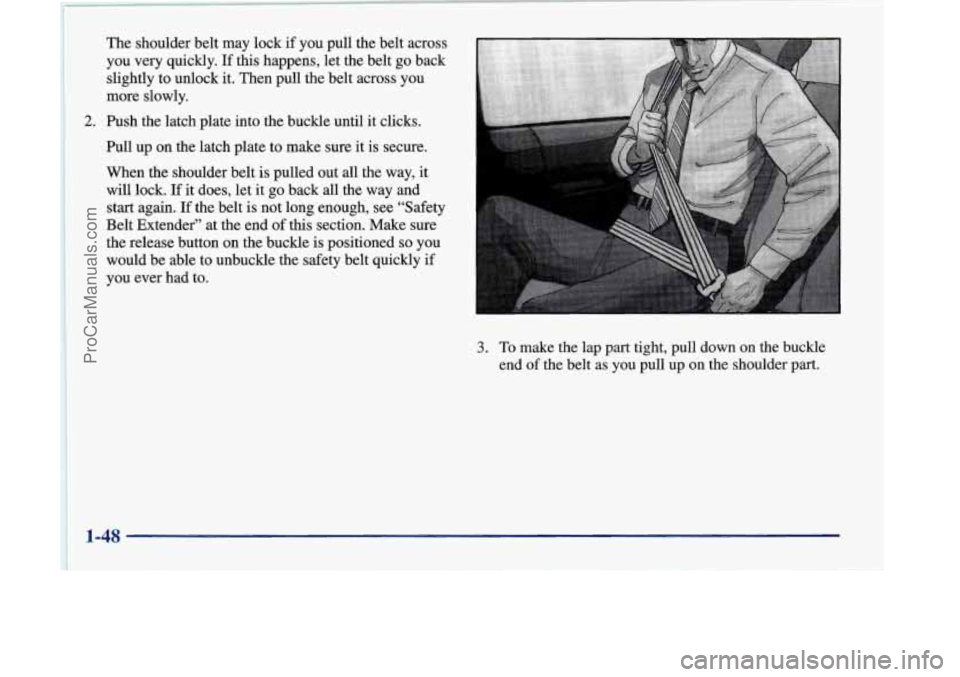
The shoulder belt may lock if you pull the belt across
you very quickly. If
this happens, let the belt go back
slightly to unlock it. Then pull the belt across you
more slowly.
2. Push the latch plate into the buckle until it clicks.
Pull up on the latch plate to make sure it
is secure.
When the shoulder belt is pulled out
all the way, it
will lock.
If it does, let it go back all the way and
start again.
If the belt is not long enough, see “Safety
Belt Extender” at the end
of this section. Make sure
the release button on the buckle is positioned
so you
would be able to unbuckle the safety belt quickly if
you ever had to.
3. To make the lap part tight, pull down on the buckle
end of the belt as you pull up on the shoulder part.
1-48
ProCarManuals.com
Page 67 of 444

When you sit in the center position bucket seat, you
have a lap safety belt which has
a retractor.
1. Pick up the latch plate and, in a single motion, pull
the belt across you. Don’t let it get twisted.
2. Push the latch plate into the buckle until it clicks. If
the belt stops before it reaches the buckle, let it go
back
all the way and start again. Pull up on the latch
plate to make sure
it is secure.
3. Feed the lap belt into the retractor to tighten it.
4. Position and release it the same way as the lap part
of a lap-shoulder belt.
If the belt isn’t long enough, see “Safety Belt
Extender” at the end of this section. Make sure the
release button on the buckle is positioned
so you
would be able to unbu&le the safety belt quickly
if
you ever had to.
1-55
ProCarManuals.com
Page 68 of 444
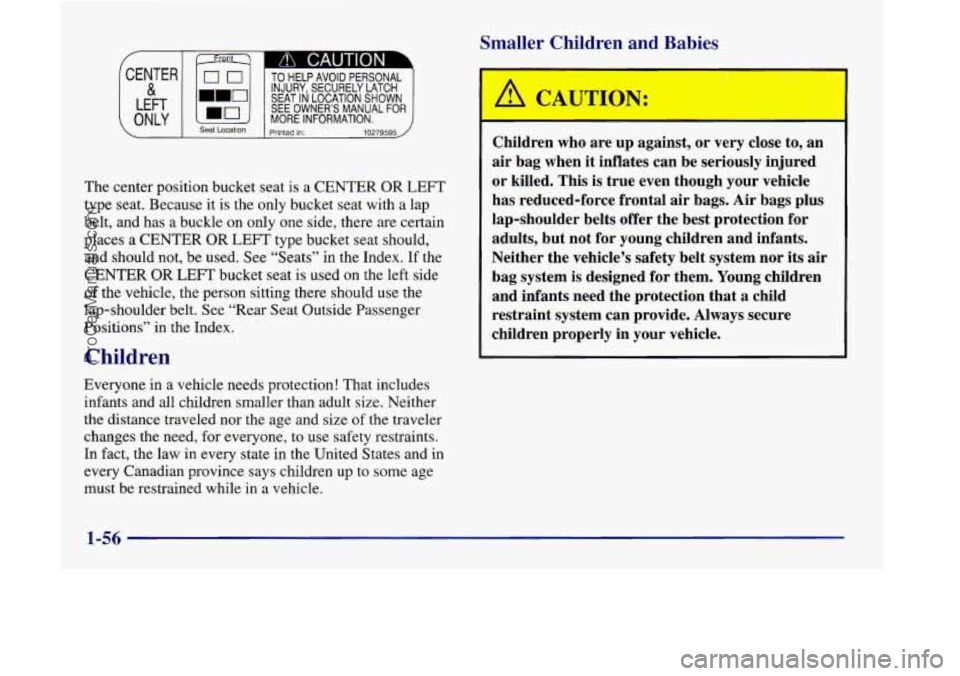
Smaller Children and Babies
c A CAUTION
TO HELP AVOID PERSONAL
SEAT IN LOCATION SHOWN
INJURY, SECURELY LATCH
SEE OWNER’S MANUAL
MORE INFORMATION. ONLY _. Seat Location printed in: 10279595
The center position bucket seat is a CENTER OR LEFT
type seat. Because it is the only bucket seat with a lap
belt, and has a buckle on only one side, there are certain
places a CENTER
OR LEFT type bucket seat should,
and should
not, be used. See “Seats” in the Index. If the
CENTER OR LEFT bucket seat
is used on the left side
of the vehicle, the person sitting there should use the
lap-shoulder belt.
See “Rear Seat Outside Passenger
Positions” in the Index.
Children
Children who are up against, or very close to, an
air bag when it inflates can be seriously injured
or killed. This is true even though your vehicle
has reduced-force frontal air bags.
Air bags plus
lap-shoulder belts offer the best protection for
adults, but not for young children and infants.
Neither the vehicle’s safety belt system nor its air
bag system is designed for them. Young children
and infants need the protection that
a child
restraint system can provide. Always secure
children properly in your vehicle.
Everyone in a vehicle needs protection! That includes
infants and all children smaller than adult size. Neither
the distance traveled nor the age and size
of the traveler
changes the need, for everyone, to use safety restraints.
In fact, the law in every state in the United States and
in
every Canadian province says children up to some age
must be restrained while in a vehicle.
1-56
ProCarManuals.com
Page 69 of 444
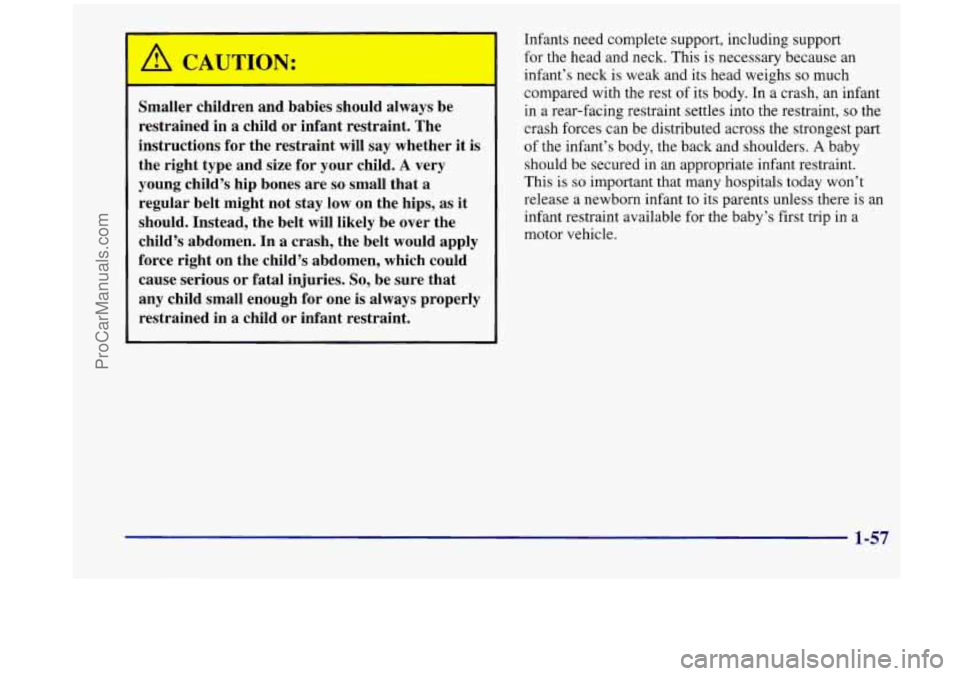
Smaller children and babies should always be
restrained in a child or infant restraint. The
instructions
for the restraint will say whether it is
the right type and size for your child. A very
young child’s hip bones are
so small that a
regular belt might not stay low on the hips, as it
should. Instead, the belt will likely be over the
child’s abdomen. In a crash, the belt would apply
force right on the child’s abdomen, which could
cause serious or
fatal injuries. So, be sure that
any child small enough for one is always properly
restrained in a child or infant restraint.
Infants need complete support, including support
for the head and neck. This is necessary because an
infant’s neck is weak and its head weighs
so much
compared with the rest of its body. In a crash, an infant
in a rear-facing restraint settles into the restraint,
so the
crash forces can be distributed across the strongest part
of the infant’s body, the back and shoulders. A baby
should be secured in an appropriate infant restraint.
This is
so important that many hospitals today won’t
release a newborn infant to its parents unless there is an
infant restraint available for the baby’s first trip in a
motor vehicle.
1-57
ProCarManuals.com
Page 70 of 444
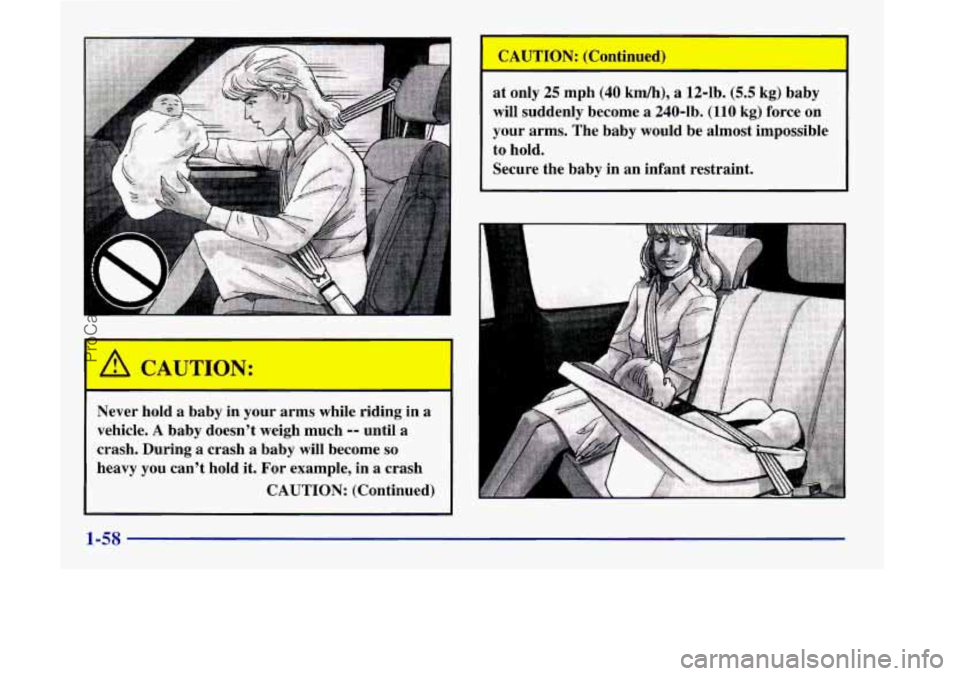
I A CAUTION:
1 Never hold a baby in your arms while riding in a
vehicle. A baby doesn’t weigh much -- until a
crash. During a crash a baby will become so
heavy you can’t hold it. For example, in a crash
CAUTION: (Continued)
at only 25 mph (40 kmh), a 124b. (5.5 kg) baby
will suddenly become
a 240-1b. (110 kg) force on
your arms. The baby would be almost impossible
to hold.
Secure the baby in an infant restraint.
.
1-58
ProCarManuals.com
Page 73 of 444
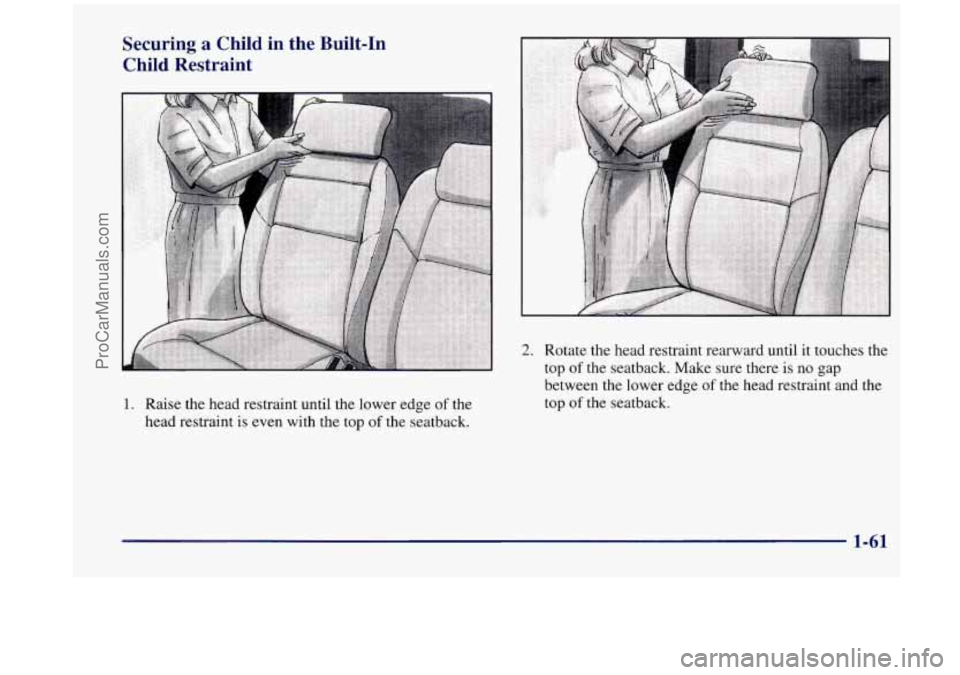
Securing a Child in the Built-In
Child Restraint
1. Raise the head restraint until the lower edge of the
head restraint is even with the top
of the seatback.
2. Rotate the head restraint rearward until it touches the
top
of the seatback. Make sure there is no gap
between the lower edge
of the head restraint and the
top
of the seatback.
1-61
ProCarManuals.com
Page 74 of 444

3. Lower the child restraint cushion. You’ll be using the child restraint’s harness (A) to
secure your child. Don’t
use the vehicle’s
safety belts.
1-62
ProCarManuals.com